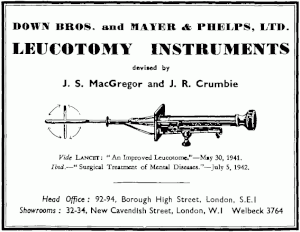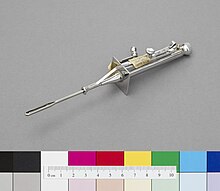Leucotome

A leucotome or McKenzie leucotome is a
leucotomies (also known as lobotomy) and other forms of psychosurgery
.
Invented by
Egas Moniz.[2]

Another, different, surgical instrument also called a leucotome was introduced by
ice-pick, it consisted simply of a pointed shaft. It was passed through the tear duct under the eyelid and against the top of the eyesocket. A mallet was used to drive the instrument through the thin layer of bone and into the brain along the plane of the bridge of the nose, to a depth of 5 cm. Due to incidents of breakage, a stronger but essentially identical instrument called an orbitoclast was later used.[4]
Lobotomies were commonly performed from the 1930s to the 1960s, with a few as late as the 1980s in France.[5]
See also
Notes
- ^ "Kenneth G. McKenzie". Congress of Neurological Surgeons. 1954-07-01. Retrieved 2023-11-05.
- ^ "The Nobel Prize in Physiology or Medicine 1949". NobelPrize.org. Retrieved 2023-11-05.
- ^ "The Museum of Medicine and Health : Leucotome". Manchester Digital Collections. Retrieved 2023-11-05.
- ^ "'My Lobotomy': Howard Dully's Journey". NPR. 2005 [2005-10-16]. Retrieved 2023-10-05.
- Comité Consultatif National d'Ethique. 2002-04-25. Archived from the original(PDF) on 2011-07-20. (French national consultative committee on ethics, opinion #71: Functional neurosurgery of severe psychiatric conditions)
External links
- A leucotome from the University of Manchester Medical School Museum
- The Nobel Foundation page on prefrontal leukotomy
